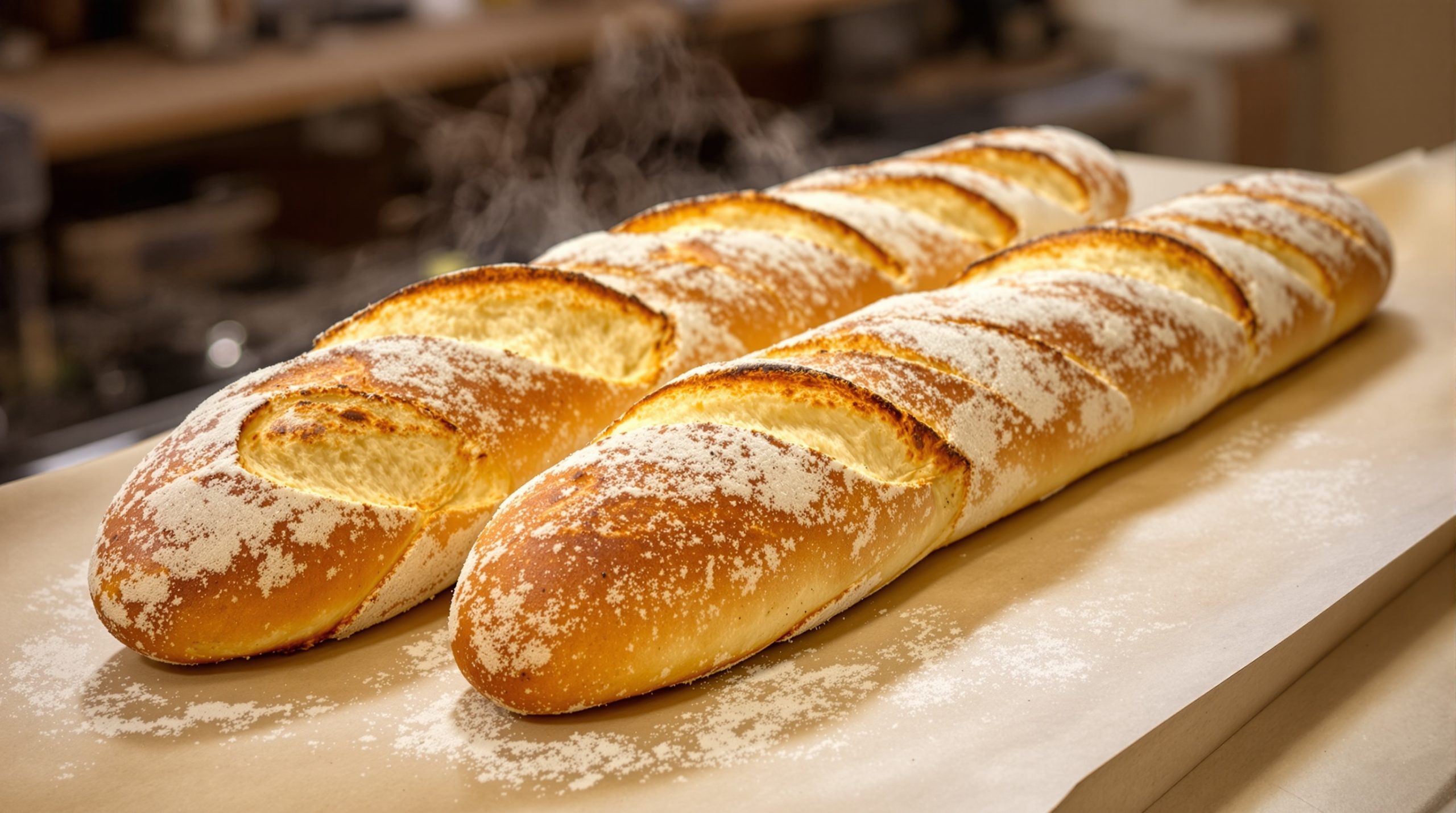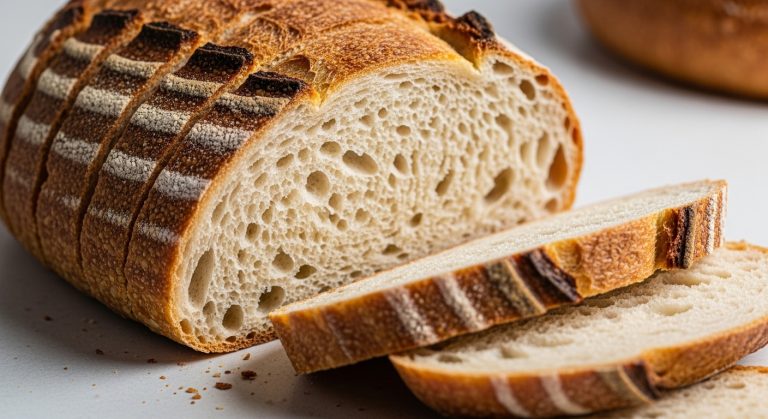Sourdough Discard Baguette Recipe: Crusty, Golden Perfection
You can turn your sourdough discard into flavorful baguettes by mixing it with bread flour, water, salt, and a bit of active starter for rise and depth.
After a brief autolyse and several gentle stretch-and-folds during fermentation, shape your dough carefully into slender loaves.
Bake on a hot stone with steam to get that perfect crispy crust and open crumb.
Ready to explore detailed steps and pro tips for your best sourdough baguette ever?
Key Takeaways
- Use 200g sourdough discard combined with 100-200g active starter and 430-625g bread flour for a balanced dough base.
- Hydrate dough to around 70-80% and mix using autolyse, followed by stretch-and-fold every 15-30 minutes for gluten development.
- Bulk ferment at 75°F for 2 to 2.5 hours with multiple stretch-and-folds, optionally retarding in fridge for enhanced flavor and texture.
- Shape dough into baguettes by dividing, pre-shaping rounds, resting, then stretching and folding into classic tapered forms.
- Bake at 450°F with steam for 10 minutes on a stone or steel, then remove steam and cool with oven door ajar for crisp crust.
The Ultimate Sourdough Discard Baguette Recipe Table
| Step | Details | Pro Tips |
|---|---|---|
| Ingredients | 200g sourdough discard (100% hydration), 100–200g active starter, 430–625g bread flour, 430–463g warm water, pinch (0.3–1%) instant yeast, 2% sea salt, optional honey or oil | Use a digital scale for precise measurements to ensure consistent texture and rise. |
| Autolyse Phase | Mix starter and water, then add flour and salt to create a shaggy, sticky dough. Rest for 30 minutes. | This step builds gluten formation and enhances flavor depth. |
| Strength Building | Perform stretch and fold every 15–30 minutes for up to 6 cycles, then use coil folds with 1-hour rests. | Handle gently to retain air bubbles and achieve an open crumb. |
| Fermentation | Bulk ferment at 75°F for 2–2.5 hours, then retard dough in fridge for 12–48 hours for flavor. | Cooler fermentation enhances complexity and aroma. |
| Shaping | Divide into 175–200g pieces, pre-shape, rest, then roll and taper into baguettes. | Keep seams down to maintain surface tension. |
| Proofing | Let dough rise at room temperature for 2–3 hours before baking. | Dough should feel light and airy when properly proofed. |
| Baking | Preheat oven to 450°F (232°C) for 30 min, bake with steam for 10 minutes, then dry bake until golden. | Steam ensures a crisp crust; open the oven door post-bake for extra crunch. |
| Storage | Store baked baguettes in a paper bag for 1–2 days or freeze shaped loaves before baking. | Refresh in a hot oven for 5 minutes to restore crustiness. |
Ingredients Needed for the Baguette
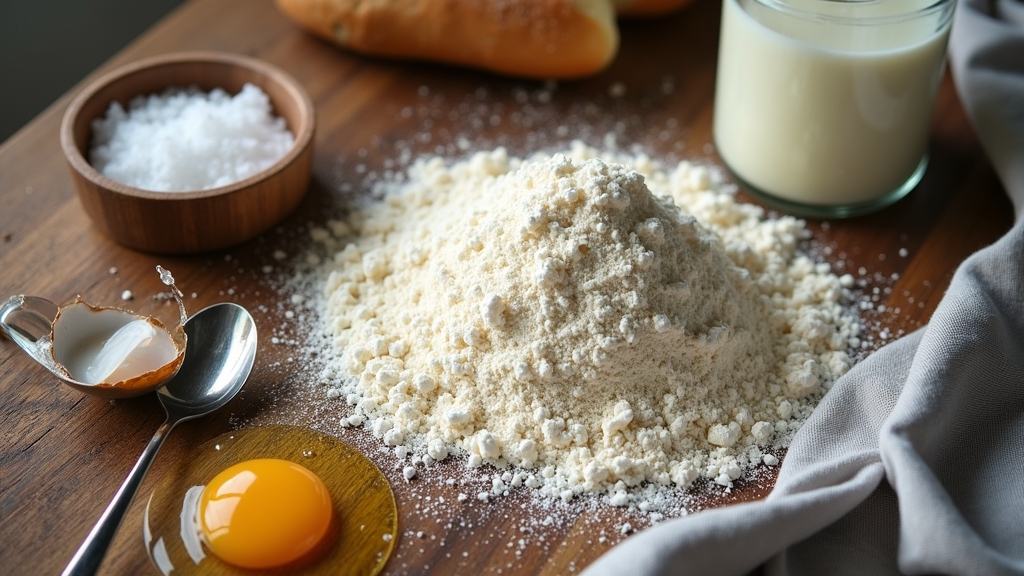
To craft a perfect sourdough discard baguette, you’ll need a carefully balanced set of ingredients that work together to create that signature crusty exterior and open, chewy crumb.
Start with about 200g of 100% hydration sourdough discard for moisture and flavor, paired with 100g to 200g of active sourdough starter to bring natural tang and fermentation power. Accurate measurement using a digital baking scale is essential to maintain consistency in your dough.
Add a tiny pinch of instant yeast, around 0.3% to 1% of flour weight, to boost leavening since discard alone lacks strong rising power.
Use bread flour, or a blend including all-purpose and a touch of whole wheat, totaling roughly 430g to 625g for structure and flavor depth.
Hydrate with warm water around 430g to 463g, aiming for 70-80% hydration. Using warm water is important to activate the yeast effectively and ensure proper dough rising.
Finish with 2% sea salt and optional honey or oil to enhance flavor and texture.
Preparing the Dough and Mixing Techniques
Although it might seem simple, preparing the dough for your sourdough discard baguette requires careful attention to mixing techniques that build gluten strength and develop flavor.
First, start with autolyse: mix your starter and water, then add flour and salt to create a shaggy, sticky dough.
Begin with autolyse by combining starter and water, then adding flour and salt for a sticky dough.
Let it rest, covered, for 30 minutes to hydrate the flour and begin gluten formation.
Next, use the stretch and fold method: every 15-30 minutes, pull the dough’s edge up and fold it over itself, rotating the bowl to strengthen gluten without overworking.
Finally, try the coil fold technique: lift and fold the dough over itself three times with hour-long rests between, preserving gas for a light crumb and better oven spring.
These steps prepare your dough perfectly for shaping. Using quality ingredients is essential to achieve the best texture and flavor in your sourdough baguette.
Fermentation and Proofing Process
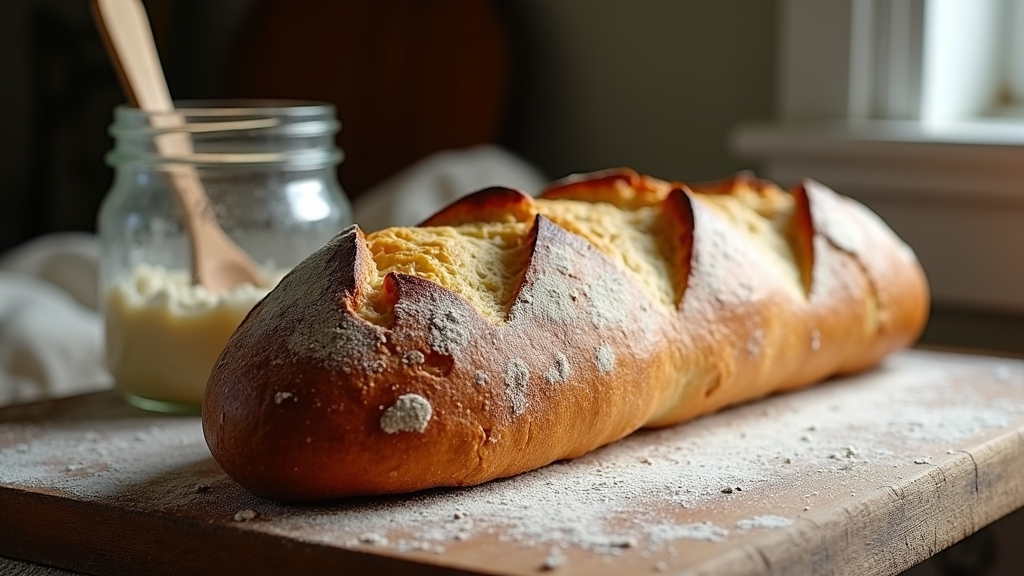
When you let your sourdough discard dough ferment and proof properly, you reveal the flavors and textures that make your baguette truly special.
Start with bulk fermentation at around 75°F for 2 to 2.5 hours, incorporating 3 to 6 stretch-and-fold cycles to build gluten strength and create an airy, bubbly dough. Maintaining the dough’s hydration at approximately 70% helps achieve the ideal crumb structure.
Consider retarding the dough in the fridge for 12 to 48 hours; this slow fermentation deepens flavor and enhances dough strength.
After shaping, proof your baguette at room temperature for 2 to 3 hours, allowing the dough to rise gently and develop ideal elasticity.
Proper fermentation produces organic acids and gases that create sour tang, open crumb, and a caramelized crust, elevating your baguette from ordinary to extraordinary.
Shaping the Perfect Sourdough Baguette
Since shaping transforms your fermented dough into the iconic baguette form, mastering this step is essential for achieving that perfect crust and open crumb.
Start by dividing your dough into equal portions (175g-200g), pre-shaping them into rounds, and letting them rest to relax gluten. Preshaping into a loose round helps create an even thickness, which is crucial for consistent shaping.
Divide dough into equal parts, pre-shape into rounds, and rest to relax gluten for better shaping.
Then, gently stretch each dough piece into a rectangle and perform letter folds to build structure and tension.
Finally, elongate and taper the dough into the classic baguette shape, keeping the seam side down to preserve tension.
Here’s how to shape like a pro:
- Use a bench scraper for precise dividing and handle dough gently to maintain gas bubbles.
- Keep your couche dusted with rice flour to prevent sticking during proofing.
- Rest dough briefly if it resists stretching to avoid tearing.
Baking Tips for a Crispy Crust
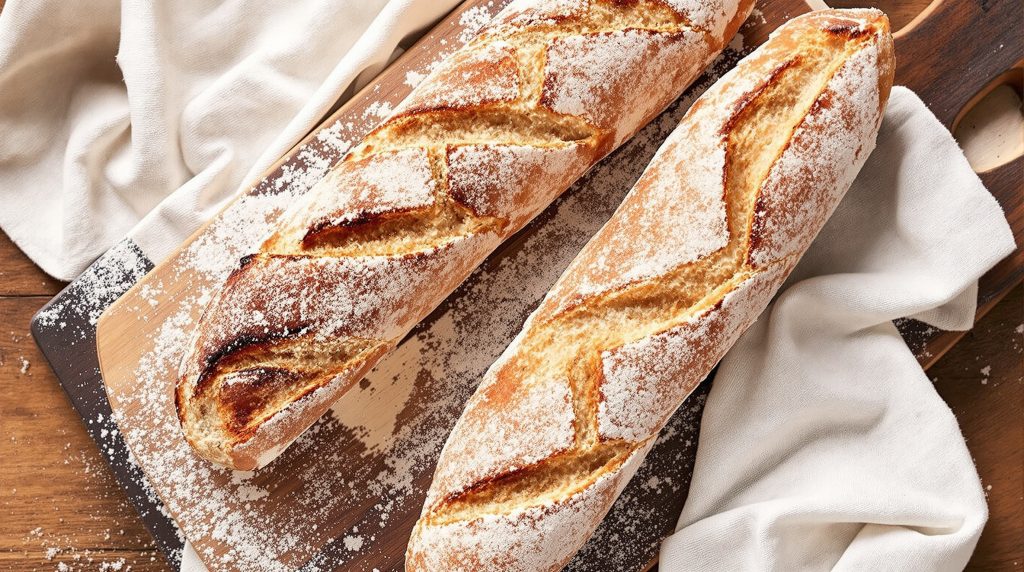
To achieve that irresistible crispy crust on your sourdough discard baguette, you’ll want to start with a properly preheated oven set around 450°F (232°C).
Preheat for at least 30 minutes using a baking stone or heavy steel tray to guarantee even heat distribution and strong oven spring.
Early in baking, introduce steam by spraying water or placing boiling water inside to hydrate starches. This delays crust setting and encourages a glossy, golden exterior.
After 10 minutes, stop steam to let the crust dry and crisp.
Once baking is done, crack the oven door open and let the residual heat crisp the crust further for about 20 minutes.
These steps, paired with sharp, angled scoring, will give you a beautifully textured, crunchy sourdough baguette crust every time.
Using Sourdough Discard Effectively
Although sourdough discard might seem like just leftover starter, it’s actually a treasure trove of nutritional benefits and baking potential that you can harness effectively.
Using discard not only reduces waste but also boosts your recipes with probiotics, improved nutrient absorption, and unique flavors. For example, Martha’s formula ensures starter health through regular feeding, which keeps your discard consistently beneficial. Potato flake starters create dough that’s lighter and milder, making them an excellent choice for incorporating discard into various recipes.
To use sourdough discard effectively, keep these tips in mind:
- Incorporate it in recipes like baguettes, pancakes, or muffins to enjoy its tangy flavor and enhanced texture.
- Adjust hydration and mixing since discard’s consistency differs from active starter, ensuring proper dough development.
- Benefit from its digestive advantages and lower glycemic impact, making your baked goods not just tasty but healthier.
Embracing discard transforms your baking while supporting sustainability and gut health.
Frequently Asked Questions
How Long Can I Store Leftover Sourdough Discard in the Fridge?
You can store leftover sourdough discard in the fridge for up to two weeks, but it’s best to use it within one week for ideal flavor and rising power.
After that, it becomes too acidic and less effective, impacting your baked goods negatively.
Keep it in a sealed glass jar at 3°C or lower, and remember to refresh it regularly to maintain its quality.
If it smells off or separates, it’s time to compost and start fresh.
Can I Freeze Shaped Baguettes Before Baking?
Yes, you can freeze shaped baguettes before baking! Just shape your dough, then freeze it quickly on a tray to keep its form.
Wrap it tightly in plastic to lock in moisture and prevent freezer burn.
When ready, thaw it slowly in the fridge or at room temperature, then proof if needed before baking.
This way, you’ll enjoy fresh baguettes with minimal effort, though some texture changes might occur compared to fresh dough.
What Are Signs My Sourdough Discard Is No Longer Good to Use?
You’ll know your sourdough discard’s gone bad if you spot any mold—white, green, pink, or orange—on its surface.
Watch for unusual dark spots, fuzzy growth, or a crusty, dried-out layer.
If it smells like nail polish remover or rotten cheese, toss it.
Excessive sliminess or off-putting chemical odors also signal spoilage.
How Do Altitude or Humidity Affect My Sourdough Discard Baguette?
When baking up high or in dry air, remember, “Every cloud has a silver lining.”
At altitude, your dough rises faster, so reduce starter and chill your water to slow things down.
Low humidity dries dough, so add extra water or fat to keep it supple.
Conversely, high humidity means wetter dough; handle it gently.
Adjust proofing times and oven temps accordingly, and you’ll bake a perfect baguette no matter the weather or altitude.
Can I Substitute Whole Wheat Flour in This Baguette Recipe?
Yes, you can substitute whole wheat flour in your baguette recipe, but expect a denser crumb and heartier flavor.
Use about 5-25% whole wheat to keep the texture light. You’ll need to increase hydration by 5-10% since whole wheat absorbs more water.
Consider adding essential wheat gluten or bread flour to maintain elasticity.
Also, extend fermentation slightly and handle the dough gently to preserve air pockets for a better rise.
Elevate Every Bake with Zero Waste Sourdough Creativity
Ready to transform your sourdough discard into a crusty, golden baguette?
With simple ingredients and a bit of patience, you’ll create bread that’s both delicious and waste-free.
Isn’t it amazing how something you’d usually toss can become the star of your kitchen?
By mastering fermentation, shaping, and baking tips, you’ll enjoy a perfectly crisp crust and soft crumb every time.
So, why not start baking your own artisan baguette today?

